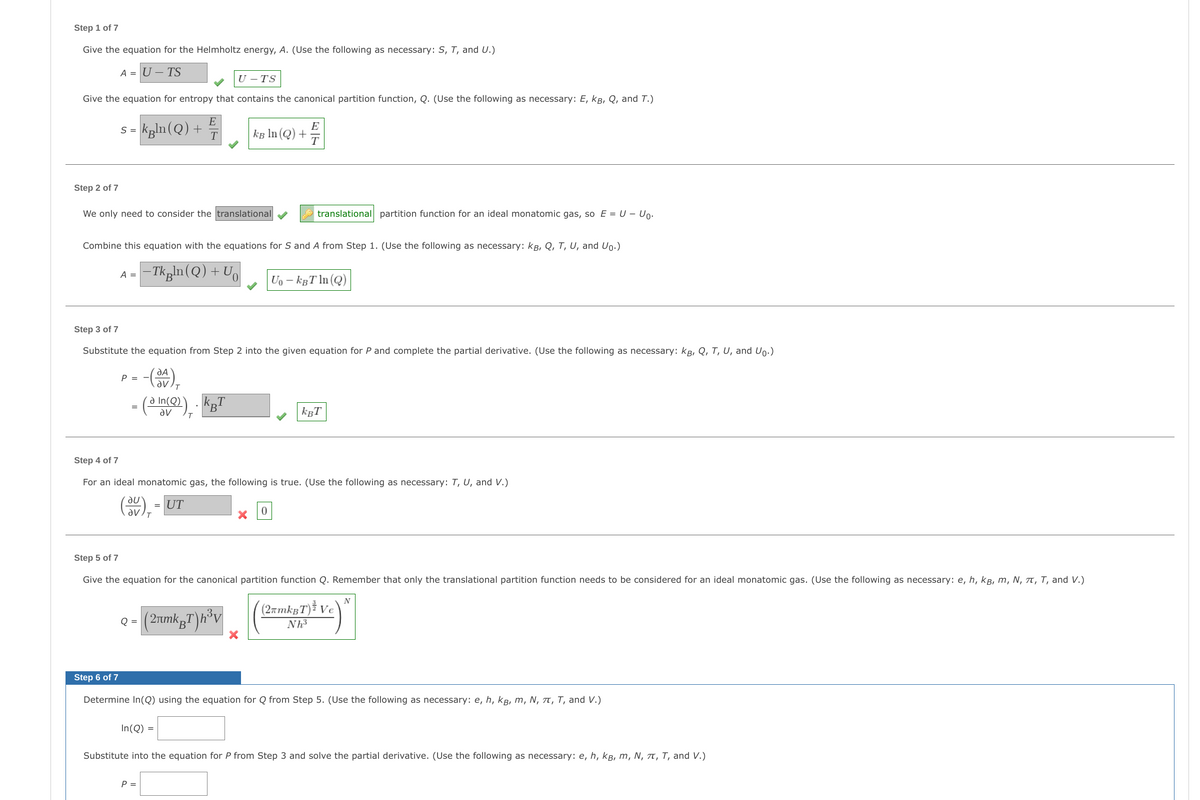Step 6 of 7 Determine In(Q) using the equation for Q from Step 5. (Use the following as necessary: e, h, kg, m, N, 7, T, and V.) In(Q) = Substitute into the equation for P from Step 3 and solve the partial derivative. (Use the following as necessary: e, h, kg, m, N, 7, T, and V.) P =
Step 6 of 7 Determine In(Q) using the equation for Q from Step 5. (Use the following as necessary: e, h, kg, m, N, 7, T, and V.) In(Q) = Substitute into the equation for P from Step 3 and solve the partial derivative. (Use the following as necessary: e, h, kg, m, N, 7, T, and V.) P =
Physical Chemistry
2nd Edition
ISBN:9781133958437
Author:Ball, David W. (david Warren), BAER, Tomas
Publisher:Ball, David W. (david Warren), BAER, Tomas
Chapter18: More Statistical Thermodynamics
Section: Chapter Questions
Problem 18.4E
Related questions
Question
100%

Transcribed Image Text:Step 1 of 7
Give the equation for the Helmholtz energy, A. (Use the following as necessary: S, T, and U.)
A = U-TS
U-TS
Give the equation for entropy that contains the canonical partition function, Q. (Use the following as necessary: E, kB, Q, and T.)
E
S = kaln(Q)+
E
T
kB ln (Q) +
4
Step 2 of 7
We only need to consider the translational
translational partition function for an ideal monatomic gas, so E = U - Uo.
Combine this equation with the equations for S and A from Step 1. (Use the following as necessary: kB, Q, T, U, and Up.)
A = -Tk ln(Q) + U₁
U₁ - kBT ln(Q)
Step 3 of 7
Substitute the equation from Step 2 into the given equation for P and complete the partial derivative. (Use the following as necessary: KB, Q, T, U, and Up.)
P =
-(3x),
・ (a In (@)), · KB¹
KBT
Step 4 of 7
For an ideal monatomic gas, the following is true. (Use the following as necessary: T, U, and V.)
UT
0
Step 5 of 7
Give the equation for the canonical partition function Q. Remember that only the translational partition function needs to be considered for an ideal monatomic gas. (Use the following as necessary: e, h, kB, m, N, 7, T, and V.)
N
(2πmkBT) Ve
Nh³
Q =
(2µmkµT)h³v
Step 6 of 7
Determine In(Q) using the equation for Q from Step 5. (Use the following as necessary: e, h, kg, m, N, T, T, and V.)
In(Q) =
Substitute into the equation for P from Step 3 and solve the partial derivative. (Use the following as necessary: e, h, kB, M, N, π, T, and V.)
P =
(au ) ₁ =
Expert Solution
This question has been solved!
Explore an expertly crafted, step-by-step solution for a thorough understanding of key concepts.
Step by step
Solved in 3 steps with 2 images

Knowledge Booster
Learn more about
Need a deep-dive on the concept behind this application? Look no further. Learn more about this topic, chemistry and related others by exploring similar questions and additional content below.Recommended textbooks for you

Physical Chemistry
Chemistry
ISBN:
9781133958437
Author:
Ball, David W. (david Warren), BAER, Tomas
Publisher:
Wadsworth Cengage Learning,

Physical Chemistry
Chemistry
ISBN:
9781133958437
Author:
Ball, David W. (david Warren), BAER, Tomas
Publisher:
Wadsworth Cengage Learning,